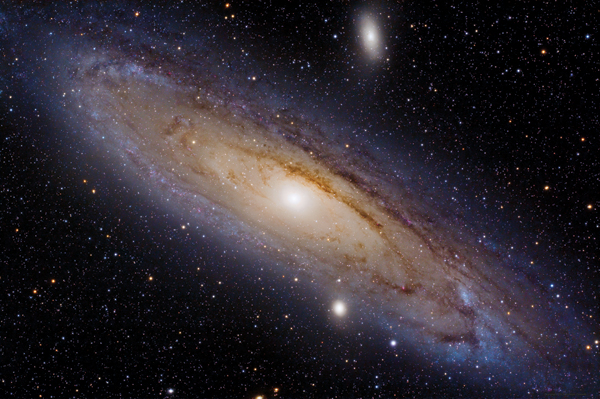A new study says our neighbor galaxy’s big stellar halo and stellar evolution are due to a major collision that ended 2 billion years ago.
A large galaxy M32 crashed into Andromeda Galaxy billions of years ago, a study says, affecting the evolution of both galaxies forever. The new study – published in Nature Astronomy – suggests the merger affected the halo of stars and globular clusters around Andromeda’s disk, as well as the pace of the galaxy’s star formation.

Lorenzo Comolli
Andromeda is the largest member of the Local Group of galaxies near the Milky Way, a spiral galaxy located about 2.5 million light-years away. Its proximity motivated researchers Richard D’Souza (University of Michigan and Vatican Observatory) and Eric Bell (University of Michigan) to understand its evolution. The researchers pulled information about how Andromeda-size galaxies came together from two different types of independent, large-scale simulations, Illustris and particle-tagging simulations. Specifically, they were interested in how Andromeda’s stellar disk came to be so thick: It’s 2,600 light-years high, eight times thicker than the Milky Way’s thin disk, even though it’s only twice as wide.
The simulations showed that such a massive stellar disk — not to mention Andromeda's massive and metal-rich stellar halo — invariably form after a large galactic collision, which plays out over billions of years. Andromeda’s stellar disk and halo have a high metallicity, or abundance of elements heavier than hydrogen and helium, which suggests that it was a massive, metal-rich galaxy that crashed into Andromeda. The two would have started interacting within the past 5 billion years, with disrupting effects continuing until 2 billion years ago.
The researchers conclude that M32, an oddly compact galaxy in orbit around Andromeda, is most likely what’s left of the galaxy that hit Andromeda. The researchers call the parent galaxy M32p and suggest that it was similar in mass to the Milky Way with a low-mass bulge in its center. Researchers had wondered for years why M32 contained so many stars in such a small volume, D'Souza says. If a collision reformed this galaxy long ago, it could explain many of its unique attributes.
The most surprising finding, D’Souza adds, is that Andromeda’s disk survived the massive merger; many previous studies suggested that such crashes would elongate a spiral galaxy into an elliptical. Yet observations show that the galaxy’s disk and bulge were already in place before the merger took place, so our neighbor galaxy maintained its spiral structure throughout the collision. Puragra GuhaThakurta (University of California, Santa Cruz), who wasn’t involved in the study, explains that not every major merger produces an elliptical galaxy. The end result depends on the exact mass ratio of the two merging galaxies and the geometry of the collision.
Additional evidence for the historic collision comes from a giant stream of metal-rich stars discovered in Andromeda’s halo in the early 2000s. Perhaps this feature is a debris field generated in the wake of the crash, the researchers suggest. Other features echo a major disruption as well. For one, about a fifth of Andromeda's stars formed about 2 billion years ago — the merger’s aftereffects may have triggered their birth.
D'Souza adds that such a major merger may have disrupted the history of the entire Local Group, but more research in this direction is needed. "This is like the missing family member nobody wants to talk about," he says. "It's a major surprise that there was something else this big that close to us."
Puragra GuhaThakurta (University of California, Santa Cruz), who wasn’t involved in the study, says that the methodology of the study is sound. Nevertheless, he argues, there’s a strong line of evidence against the idea that M32 represents the remains of a major merger — there is a giant stream of stars and gas behind M32, but nothing lies in front of it. "One generally expects the tidal debris from a merger event to be roughly symmetric about the merger remnant," he explains.
He also notes that several aspects of the scenario contain "substantial uncertainty." This includes both galaxies' mass, the movements of their stars, their star formation histories, and other items that would affect how the merger proceeded. That said, "It would be nice to be able to explain a bunch of phenomena . . . with a single major merger event," he says.
While it's unclear if M32 represents the remains of a major merger, D’Souza and Bell maintain that their work makes a strong case that something massive interacted with Andromeda. Like a business quickly trying to grow large, D'Souza says, a galaxy looking for a large leap in mass likely requires a merger with another galaxy of similar mass. He adds that more observations of Andromeda's stellar motions and composition will help bolster the case.
 0
0









Comments
You must be logged in to post a comment.